The Army Has Officially Deployed Laser Weapons Overseas to Combat Enemy Drones
The 20-kilowatt Palletized High Energy Laser, or P-HEL, "is currently deployed to support the Army's mission" in an undisclosed location abroad.
By Jared Keller
May 3, 2025
The Army has officially deployed a pair of high-energy lasers overseas to blast incoming enemy drones out of the sky, the service recently confirmed, marking a major milestone for the U.S. military's ongoing development of futuristic directed-energy weapons.
The 20-kilowatt Palletized High Energy Laser, or P-HEL, "is currently deployed to support the Army's mission" in an undisclosed location abroad, a spokesman for the service's Rapid Capabilities and Critical Technologies Office, which manages its directed-energy portfolio, told Military.com.
The P-HEL, which is based on defense contractor BlueHalo's LOCUST Laser Weapon System, "commenced operational employment" overseas in November 2022, while a second system arrived abroad "earlier this year," the company recently revealed in a press release.
BlueHalo to Provide U.S. Army with Full-Cycle Support for High Energy Laser Systems
While the Army's top general responsible for counter-drone efforts had previously stated that several different laser weapons systems were undergoing "operational assessments" in the U.S. Central Command, U.S. Africa Command and U.S. Indo-Pacific Command areas of responsibility, news of the P-HEL's operational employment marks the U.S. military's first publicly acknowledged deployment of a working laser weapon for air defense outside of experimental testing.
Maintaining lasers for counter-drone protection can be a struggle in remote locations
“Lasers are complicated. This is not a humvee that's sitting in the motor pool,” said Lt. Gen. Daniel Karbler.
The service declined to confirm whether the P-HEL had achieved a "kill" against an incoming drone yet.
"The Army remains committed to testing and integrating cutting-edge technologies, such as directed energy, as part of its ongoing efforts to ensure the safety of our soldiers and effectively support the United States' mission," the Army spokesman said.
Laser weapons work by converting electrical power into an intense stream of photons that, when narrowed through a beam director, can burn through various materials -- like, say, the carbon fiber body of a drone, the casing of a rocket or mortar, or even the hull of a small boat.
A video of P-HEL testing shared with Military.com by BlueHalo shows an operator using an Xbox controller to reposition the pallet-mounted laser array, then scanning the sky for incoming targets before locking onto a moving quadcopter drone, which soon bursts into flames and drops out of the sky.
The effect is quickly repeated on a rocket.
While the service declined to specify where the P-HEL systems were deployed, citing operational security, the Defense Department's top spokesman had previously suggested that directed-energy weapons were part of the defensive arsenal of U.S. military forces in the Middle East currently subject to the ongoing drone and missile attacks since the start of Israel's war in Gaza in October.
"I don't want to go into the specific capabilities that we're using to protect our forces, other than to say we have a wide variety which does include directed-energy capabilities," Pentagon spokesman then-Brig. Gen. Pat Ryder told reporters Oct. 31 following weeks of rocket and missile attacks on U.S. troops in Iraq and Syria.
Additionally, Gen. Michael "Erik" Kurilla, head of U.S. Central Command, told lawmakers at a Senate Armed Services Committee hearing in March that the Army had "sent us some directed-energy, mobile, short-range air defense that we are experimenting with right now over in the Middle East."
Central Command did not respond to a request for comment by deadline.
U.S. military leaders currently consider cheap weaponized drones -- like those increasingly launched at service members deployed to outposts in Iraq and Syria and warships in the Red Sea -- the greatest threat to American troops in the Middle East since the proliferation of the improvised explosive device.
Tiny Drones Are the Biggest Threat in the Middle East Since IEDs, Top General Says
In January, three American service members were killed in a drone attack on a military outpost in Jordan, while the Pentagon had seen an additional 183 casualties among troops deployed to Iraq and Syria (including more than 130 traumatic brain injuries) as of February as the result of drone and missile attacks.
Luck Has Prevented More US Casualties from Drone Attacks in Iraq and Syria, Top Mideast General Says
The P-HEL's employment comes as the U.S. military seeks to bolster its air defense capabilities to protect service members abroad not just with expensive conventional munitions -- such as the $2.1 million Standard Missile-2 naval missile and the $480,000 Stinger missile that have helped run up a $1 billion tab for the Pentagon in the Middle East since October -- but effective, lower-cost, counter-drone solutions that can knock incoming threats out of the sky without breaking the bank.
A $2M missile vs. a $2,000 drone: Pentagon worried over cost of Houthi attacks
“That quickly becomes a problem because the most benefit ... is in their favor,” one expert said.
Indeed, the Army's fiscal 2025 budget includes roughly $447 million for research, development, testing and evaluation for counter-drone programs, according to the service, $140 million of which is focused on directed-energy efforts.
But the Pentagon isn't waiting for R&D to aggressively boost its air defenses.
The Army in February inked a deal with defense contractor Raytheon for hundreds of Coyote Block 2C interceptors -- at $100,000 a shot -- explicitly to support its counter-drone initiatives in the Middle East.
Army buys 600 additional Coyote counter-drone weapons amid attacks on US troops
The Coyote is a ground-launched, radar-guided interceptor.
The Navy in April put in an "urgent" order to MSI Defense Solutions for the truck-mounted Electronic Advanced Ground Launcher Systems, or EAGLS, armed with laser-guided Advanced Precision Kill Weapon System II rockets -- $25,000 each -- to combat "emerging and persistent [drone] threats" in the Central Command area of responsibility.
Laser Rocket Anti-Drone Systems Being Rushed to U.S. Forces in The Middle East
The Navy put in an order for new Electronic Advanced Ground Launcher System just ahead of Iran's missile and drone strikes on Israel.
Meanwhile, both the Army and Marine Corps are aggressively on the hunt for additional counter-drone tech.
Army, Marine Corps ping industry for more counter-drone tech
The Army and Marine Corps recently released an RFI and RFP, respectively, for technologies that can defeat unmanned aerial systems.
If operationally proven, a laser weapon could drastically turn that cost calculus on its head: The average laser weapon costs between only $1 and $10 per shot, according to a 2023 report from the Government Accountability Office.
And military commanders are thinking beyond just lasers.
In March, Kurilla called on lawmakers to consider expediting the development of high-powered microwaves -- directed-energy weapons that can blanket an area with powerful electromagnetic radiation, disabling multiple targets simultaneously -- to fill in gaps in U.S. air defenses in the Middle East.
Top General in Mideast Calls for Microwave Weapons for 'Layered' Defense Against Drone Swarms
"The bigger concern is if you start talking about [drone] swarms, so we need to continue to invest in things like high-powered microwave [sic] to be able to counter a drone swarm that is coming at you," Kurilla said.
"I mean, nothing is 100%. And at some point, the law of statistics will come up to you. You have to have layered defense."
The P-HEL isn't the first high-energy laser system to see action overseas in the hands of U.S. troops downrange, but its current deployment as an air defense solution for the Army is a watershed moment for the service's directed-energy weapons.
And the P-HEL's deployment may be a sign of things to come.
In recent months, the Army has not only deployed a platoon of four 50-kilowatt Directed Energy Maneuver-Short Range Air Defense, or DE M-SHORAD, prototypes to Central Command for "real world testing," but taken possession of its most powerful laser yet -- the 300-kilowatt Indirect Fire Protection Capability-High Energy Laser, or IFPC-HEL -- to potentially counter incoming cruise missiles.
A Moment of Truth for the Army's Chief Laser Weapon
The service also last year awarded a contract to P-HEL maker BlueHalo for an additional 20-kilowatt laser system for the so-called Army Multi-Purpose High Energy Laser, or AMP-HEL, which will eventually integrate into the service's upcoming Infantry Squad Vehicle.
The Pentagon currently spends roughly $1 billion a year on directed-energy weapons and has 31 different systems at various stages of development, the majority of which are laser systems, Defense News recently reported.
Share or comment on this article.
Your support is crucial in exposing fake news and in helping us defeat mass censorship.




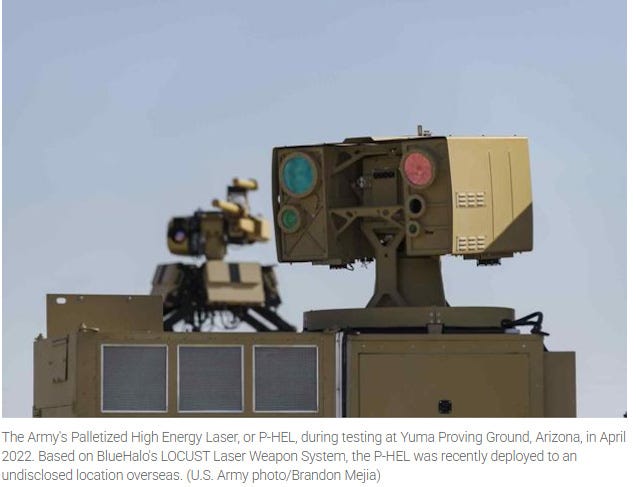




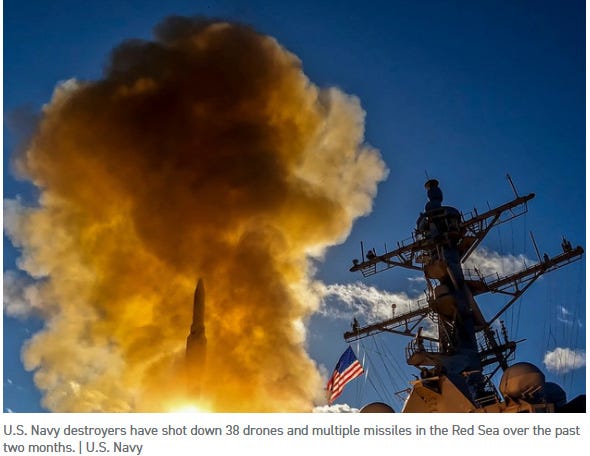
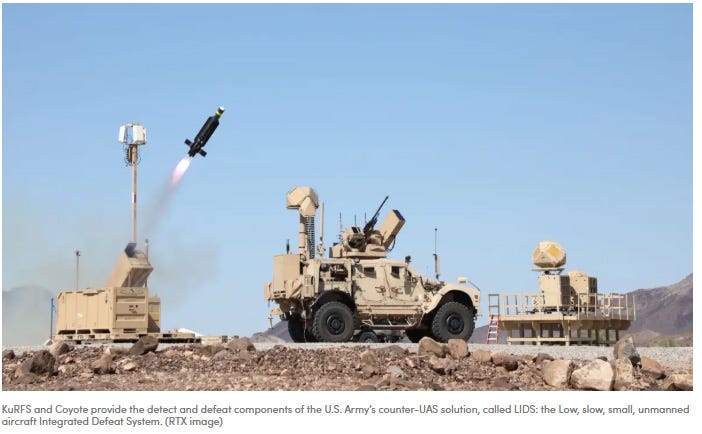



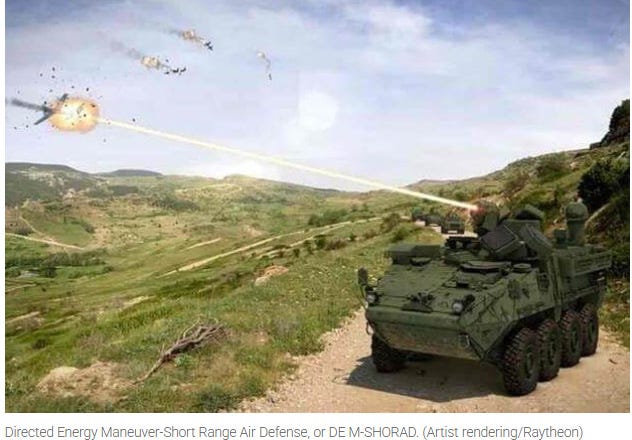
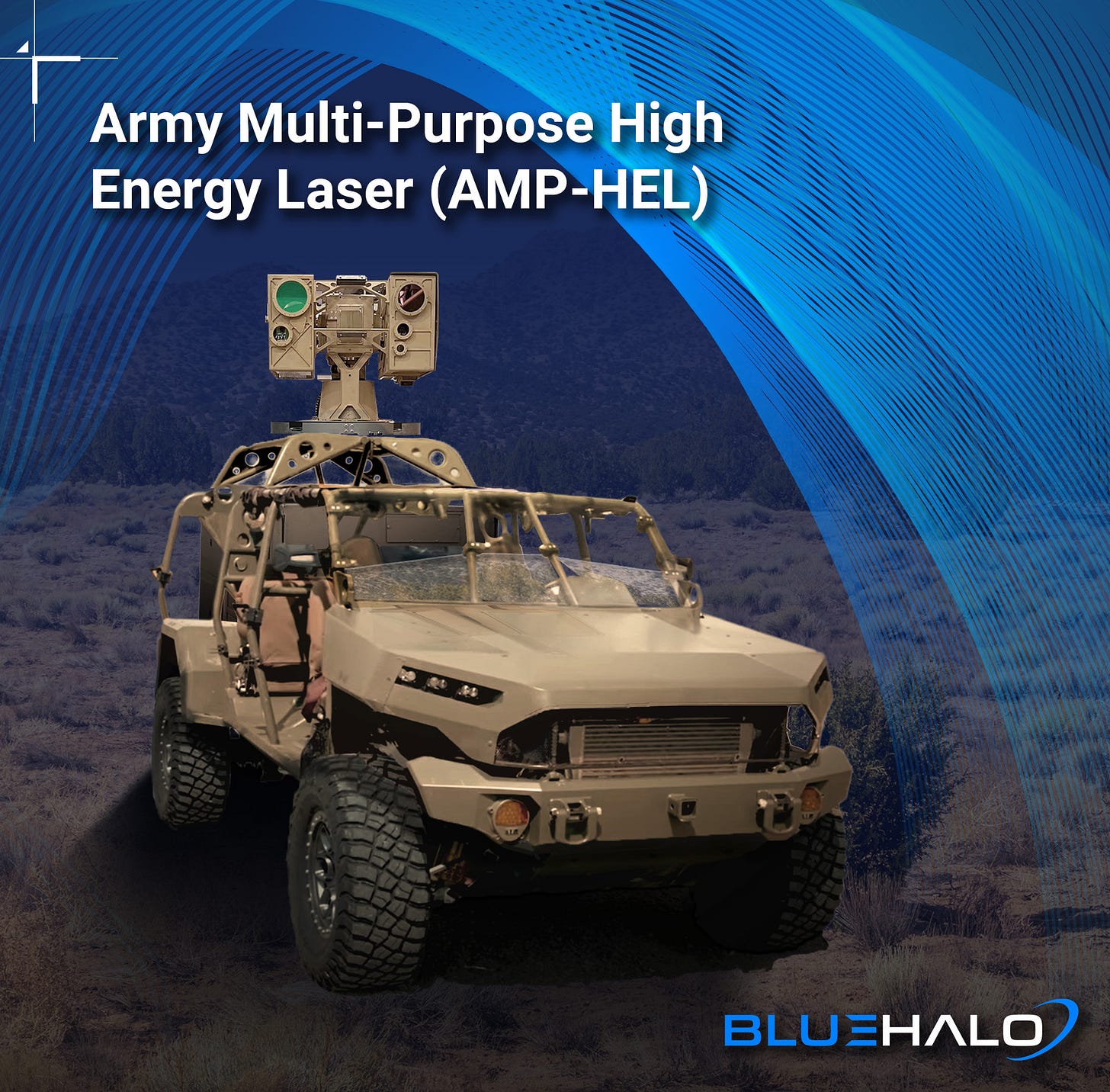


Thanks for reposting my article I guess?
Currently fielded DEW weaponry can be easily overwhelmed due to power demands and the not insignificant time required to recharge between each engagement. It’s not the panacea it’s touted as. It’s the same limitation that plagues all electric tools, vehicles, and weapons.